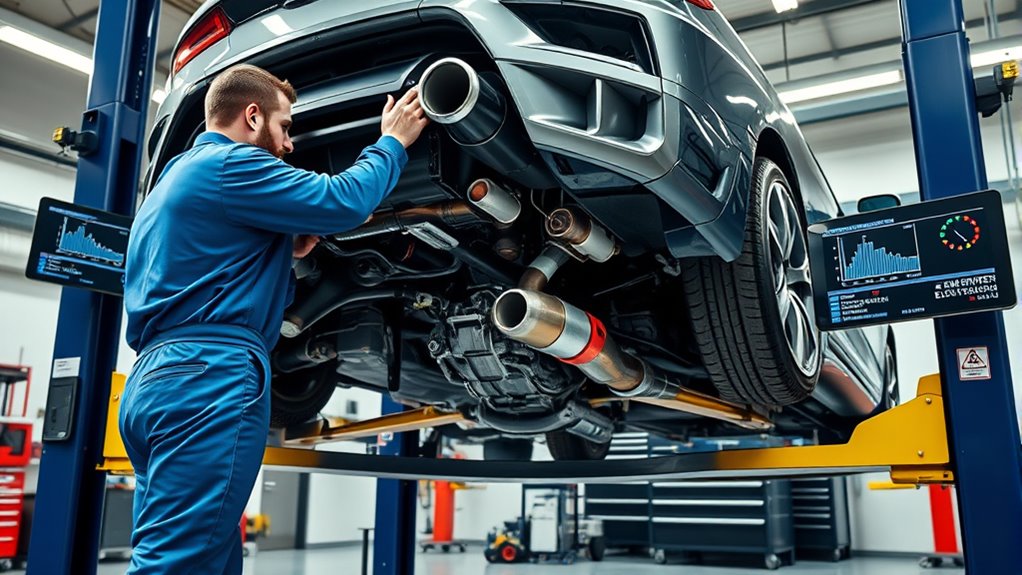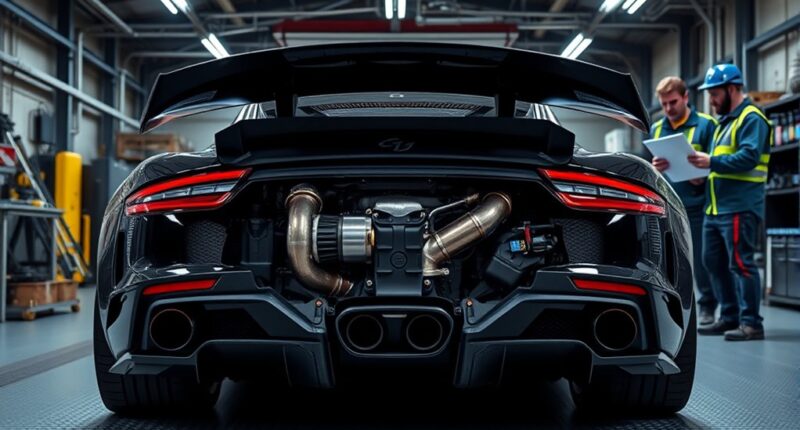To navigate EU emission standards when retrofitting performance parts, you need to guarantee all components are certified or approved for EU use. Research thoroughly before buying, and choose parts that meet strict emission regulations to avoid fines or legal issues. Keep detailed records of modifications and consult with specialists to confirm compliance. Balancing performance upgrades with regulatory requirements can be tricky, but by following these steps, you’ll be better prepared to stay within limits as you move forward.
Key Takeaways
- Research and verify that aftermarket parts are certified or approved for EU emission compliance before installation.
- Keep detailed documentation of all modifications to demonstrate adherence during inspections.
- Consult with emissions specialists to ensure necessary adjustments, like emission control device integration, are properly implemented.
- Avoid unauthorized or unapproved aftermarket parts that could compromise vehicle compliance and lead to legal issues.
- Stay updated on evolving EU regulations to ensure ongoing compliance of retrofitted performance components.

As European Union emission standards become increasingly stringent, retrofitting existing vehicles has emerged as a practical solution to meet these new requirements. If you’re considering performance upgrades or aftermarket modifications, you need to be aware of the compliance challenges that come with fitting new parts to your vehicle. The aim is to enhance your vehicle’s performance without crossing regulatory boundaries, which can be tricky given the strict emission limits now in place.
When retrofitting your vehicle with aftermarket modifications, your first concern should be ensuring that the changes don’t violate EU regulations. Many performance parts claim to boost power or efficiency, but they can also alter emissions profiles. If these modifications aren’t properly approved or certified, they could lead to legal complications, fines, or even vehicle impoundment. The challenge lies in balancing performance gains with compliance, especially when aftermarket parts are often developed without full regard for emission standards. You might find yourself facing compliance challenges, requiring detailed documentation to prove that your modifications meet the necessary thresholds.
To navigate these issues, you’ll need to do thorough research before purchasing any performance parts. Look for components that are certified or approved for use within the EU, which often means checking for CE markings or other official certifications. It’s also wise to consult with professionals who specialize in vehicle emissions compliance. They can help determine whether a particular aftermarket modification is compatible with EU standards or if additional adjustments are necessary. Some modifications might require installing specific emission control devices or recalibrating your vehicle’s engine management system to ensure ongoing compliance.
Another important step is to keep detailed records of any modifications you make. Documentation proves that your vehicle has been properly retrofitted and can be useful during inspections or if you need to demonstrate compliance to authorities. Remember, even if a performance part is legal in other regions, it doesn’t automatically mean it’s compliant with EU emission standards. You’ll need to verify the regulatory status of each component and possibly seek approval from relevant authorities to avoid penalties.
Ultimately, retrofitting your vehicle for better performance while adhering to EU emission standards involves careful planning and diligent research. While aftermarket modifications can give your vehicle a boost, they come with compliance challenges that shouldn’t be overlooked. Staying informed about the latest regulations, using certified parts, and consulting experts can help you achieve your goals without risking legal issues. By taking these steps, you ensure your vehicle remains both high-performing and compliant with the stringent standards set by the EU. Understanding emission standards is key to successfully navigating the retrofit process.
Frequently Asked Questions
How Do Retrofits Impact Vehicle Insurance Policies?
When you retrofit your vehicle, you should consider the insurance implications and potential policy adjustments. Insurance companies often view modifications as increased risk, which can lead to higher premiums or coverage restrictions. It’s crucial to inform your insurer about any upgrades, especially performance parts, to guarantee your policy remains valid. Failing to disclose modifications could result in denied claims or policy cancellations, so always update your coverage accordingly.
Are There Specific EU Standards for Electric Vehicle Performance Parts?
Did you know that over 30% of electric vehicle aftermarket parts seek EU certification? When retrofitting performance parts, you must guarantee they meet EU standards, as aftermarket regulations require compliance for safety and legality. EU standards for EV performance parts focus on safety, efficiency, and environmental impact. Always verify that your upgrades align with these regulations to avoid penalties and ensure your vehicle remains roadworthy under current EU rules.
What Are the Penalties for Non-Compliance With Emission Standards?
If you don’t meet emission standards, you face serious consequences. Emission penalties can include hefty fines, compliance fines, and even restrictions on vehicle registration or use. Non-compliance can lead to legal actions, increased costs, and damage to your reputation. To avoid these penalties, verify your retrofitted parts adhere to EU emission regulations, and stay updated on any changes to standards. Staying compliant protects your investment and keeps your vehicles legally operable.
Can Retrofitting Improve a Vehicle’s Resale Value Legally?
Think of your car’s resale value as a garden that thrives with careful nurturing. Retrofit legality plays a crucial role; when done within legal boundaries, it can make your vehicle more appealing, boosting resale. Quality upgrades act like fertilizer, enhancing performance and attractiveness. However, illegal retrofits can turn this garden into a weed patch, harming your vehicle resale prospects. Stay compliant, and your car’s value will blossom.
How Often Do EU Emission Standards Change for Retrofitted Vehicles?
You might wonder how often EU emission standards change for retrofitted vehicles. Emission updates typically occur every few years, with standard variations depending on new regulations or technological advancements. These updates aim to reduce emissions and improve vehicle efficiency. Staying informed is vital, as retrofit modifications must meet current standards. Regularly check official EU sources to guarantee your vehicle complies with the latest emission requirements and avoid potential legal issues.
Conclusion
Mastering EU emission standards during retrofitting can seem intimidating, but understanding the rules empowers you to upgrade responsibly. While performance parts boost your vehicle’s power and excitement, they also carry strict compliance requirements. Balancing these goals, you’re not just enhancing your ride but also protecting the environment. It’s a reminder: pushing for performance doesn’t mean ignoring regulations. With careful planning, you can enjoy both a thrilling drive and a cleaner future—because responsible modifications are the true mark of a savvy enthusiast.










